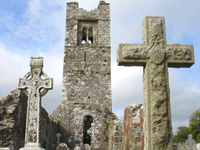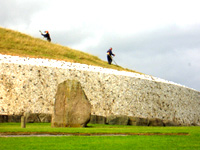|

The Sweeping Melancholy of Eastern Ireland
by Amanda
Castleman
Diarmaid
Rankin shows us castles and churches, tombs and monasteries
and long-forgotten forts. As an aside, the 40-year-old chronicles
his own ruins. "That was my father's iron yard," he
points to a rusted and derelict wall midriver. "Here was
my aunt's cottage. Her helper was a bit simple, but Mae just
instinctively knew when someone wanted something. No need for
words."
Vines
tug at the mortar chunks. The scene is forlorn: surely a home
abandoned centuries - not years - ago? But the women lived right
here in the Mourne Mountains, not three decades past.
 |
|
Graves
and the bell tower at the ruins of Mellifont Abbey |
Such
sweeping melancholy is typical of Ireland's eastern coast. Something's
in the jagged North Sea spray, the granite-chunked crags and
the heather that creeps in on little cat feet. And that something
erodes and erases and exiles. Bones bleach into fable. Whiskey
washes away fact. Then ivy muffles it all into mythology.
St
Bronach's bell is the sound of this silence. A faint "Gong-gong;
goooooo" tolled whenever storms swamped the harbor. Townsfolk
decided that the local virgin saint was summoning them to aid
shipwrecks. But no, a bronze bell - hidden during the Reformation
- swayed in a tree, which slowly encased its shape. Cocooned
in the branches, it slipped from history's stream, forgotten.
Only the greatest gusts could produce a soft chime: misinterpreted
as a sacred whispered warning.
One
hundred years ago, a storm finally shattered the trunk - the
bell was found, the legend lost. A church has sheltered it since;
a rubber-headed mallet pokes past its brass security bars. "Go
on, hit it," Rankin insists. "Everyone should hear
history for themselves."
Like
the landscape, the bell is sweet and strange. Wildness lingers
in the overtones. But that's the way of this country, converted
to Christianity by Saint Patrick in the fifth century, but still
somehow pagan at its core.
The
philosopher Henri Bergson once described humor as "something
mechanical encrusted upon the living." Ireland is the somber
inverse: something living encrusted upon the mechanical. Human
conceits are mellowed by moss, undermined by roots, pushed to
foreign shores by potato blight. Small
wonder the Irish are such bold warriors and drinkers and Blarney-touched
storytellers. Endeavor is their only weapon against erosion.
Nevertheless,
this proud people erected monuments that survived both wind
and water, not to mention Viking raids and, more recently, strife
between the IRA and British. Newgrange is one such site: older
than Stonehenge, the passage tomb is a wide, low pancake on
the Meath plain. Milky quartz glitters on the exterior, beside
slabs inscribed with inscrutable swirls.
A
weed whacker hums and hacks atop the 5,200-year-old mound. Each
year, dawn ignites the grave's inner chamber for five days around
the winter solstice. Maybe the sun swept away the souls. Or
maybe it was just a flashy bit of Neolithic engineering. Nobody
will ever know.
Lost
for centuries, stones wrenched away as paving, Newgrange slid
under the sod. In 1699, laborers quarried more boulders from
the cairn and discovered this sublime structure. Some legends
claim it was a continuous font of fruits, roasted pigs and caskets
of ale. Except who would misplace such a thing for millennia?
Perhaps
the same people whose descendants crashed a school bus into
the Market Cross of Kells. This heritage town is, of course,
most famous for its illuminated manuscript (nabbed by Trinity
College and now displayed in Dublin). But five high crosses
mark its ancient roads - several still in use - and accidents
happen.
Louise
Gargan, manager of Kells Heritage Center, sighs as she pats
a copy of the ninth-century scripture. "We have a two-ton
replica inside and the actual one outside. Erosion is a recent
problem."
 |
Weed whacker hum atop Newgrange, a Neolithic passage tomb |
The
star-crossed monument has suffered much abuse. Oliver Cromwell's
soldiers practiced marksmanship on it. Fallen, it moldered
on the ground, until pundit Jonathan Swift modestly proposed
its resurrection. The English hung Irish rebels on its arms
in 1798. Later, its perch became the corner of two heavily traveled
highways: hence the 1996 crash, which toppled it again. Conservationists
shifted it to the Heritage Center grounds, but outcry kept the
sculpture outside.
Kells
doesn't want its Market Cross to come in from the cold. Doreen
Fitzsimmons, educational tour guide, notes: "The townspeople
said 'no, we're not having it. It belongs to all of us.'
"When
things happen like the tsunami or 9-11, flowers and candy appear
on this cross. People still sit on the base of an evening."
She gestures to its former site, where the N3 and N52 intersect.
"It might even come back when the bypass is put through," she says, hope tinting her voice.
Kells'
three other high crosses are exposed to the elements as well:
great limestone lumps of history, drooling into the ground.
Acid rain and traffic tremors strip their medieval features.
Maybe
it's for the best, though. Maybe these monuments, raised in
defiance against the harsh, haunting landscape, should melt
back into it, much like the Native Peoples' totems in British
Columbia, Canada. Maybe they should pass into myth - Rankin's
silver-tongued tales - and then beyond to Mae's wordless wisdom,
as the sea spray once again cleans Ireland's slate, all better
to let her heroics bloom again.
IF
YOU GO |
Exploring
The passage grave at Newgrange, surrounded by over 90
ancient monuments and earthworks, is now a World Heritage
Site (€2.75 adult; 2km west of Donore Village on
the L21; 41 988 0300). Visit the sweeping earthworks,
coronation site of the High Kings: the Hill of Tara (€2
adult; 15 minutes south of Navan off the N3; 46 902 5903).
Hugh
de Lacy built Trim Castle - later "Braveheart's"
film set - in 1173 (€3.50 adult, Trim town, 46 943
8619). Walk around the monastic enclosure at Kells, home
to Saint Columba, then visit the Heritage Centre (€4
adult; the old Courthouse, Navan Road, Kells; 46 924 7840).
The website www.meathtourism.ie contains information on all these sites.
Resting
In Dublin, Stephens Hall Hotel is a chic and central choice.
The suites all feature meeting rooms with kitchenettes,
as well as separate sleeping chambers. Wi-Fi crackles
downstairs - a rarity despite the tech-boom in Ireland.
(Lower Leeson Street, Dublin 2; 638 1111; www.premgroup.com).
The same company offers 46 short-term leases in the city
center under the business name Premier Apartments (from
€80 per night for a double).
Closer
to Newgrange, the Ghan House is an eighteenth-century
Georgian manor, perched between the loch and mountains.
Atmospheric antiques include canopy and bunk beds. Elegant
and relaxed, this hotel boasts a gourmet menu and wine
list, as well as a cookery school (Carlingford, County
Louth; 42 937 3682; www.ghanhouse.com).
Budget
travelers may prefer the Kells Hostel, which has dormitories
and en-suite bedrooms, plus camping in the summertime.
This facility - with both laundry and a self-catering
kitchen - conveniently stands beside the Dublin bus stop
(Kells, County Meath, 46 924 9995; www.kellshostel.com).
Traveling
Dublin Airport is six miles north of the city center,
close to the M50 and M1 highways (www.dublin-airport.com).
International carriers include Aer Lingus (www.aerlingus.com),
Delta (www.delta.com),
Continental (www.continental.com)
and the no-frills Ryan Air (www.ryanair.com).
The inexpensive Aircoach runs round the clock (€7
one-way or €12 return; www.aircoach.ie).
Taxi fare costs around €15, but always request an
estimate before setting off.
The
best way to tour eastern Ireland is by bicycle. Irish
Cycle Hire offers a superb seven-night tour which stops
at Carlingford, Kells, Trim, Tara and Newgrange (€1,200
per person sharing includes a guide, five evening meals,
seven nights accommodation, equipment hire and luggage
transfer - a great introduction to both the sport and
country. Enterprise Centre, Ardee, County Louth; 041 685
3772; www.irishcyclehire.com).
Learning
Tourism Ireland supplies a friendly welcome and glossy
pamphlets galore (345 Park Avenue, 17th Floor, New York,
NY 10154; 212-418-0800 or toll-free 800-223-6470; www.tourismireland.com).
The best urban guidebook is "Time Out Dublin,"
edited by Christi Daugherty. Brian Lalor's "Blue
Guide Ireland" provides more comprehensive coverage
of art and history. |
|